Germania Inferior (9)
Q152136Germania inferior: small province of the Roman empire, situated along the Lower Rhine. Its capital was Cologne.
Religion
In the preceding parts of this article, the native religion of Germania Inferior has already been mentioned several times. However, we know hardly anything about this interesting subject, because we lack contemporary written sources on ancient religion. We do not possess a single text in which an adherent of polytheism describes his or her religious believes - there is simply no pagan equivalent of the Confessions, the spiritual autobiography of the Christian author Augustine of Hippo. In other words, when we read that the Atuatuci were convinced that Julius Caesar received divine help, or that Tiberius was greeted as a god on the banks of the river Elbe, we do not know what this meant to the people involved.
Therefore, we will have to confine ourselves to an overview of the evidence - which is not the same as an overview of the native religion. There are four types of evidence:
- inscriptions;
- illustrations;
- fairy tales, sagas, and customs;
- and the writings of Greek and Roman authors.
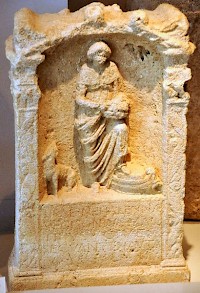
To start with, there are votive altars with inscriptions. Although hundreds of these inscribed stone monuments have been discovered, they do not contain much information. Usually, the inscription says only that a man has kept his promise to dedicate a monument to a god or goddess. The last words are nearly always that he did it "willingly and deservedly" - often abridged to LM (libens merito). Sometimes, we learn the cause of the dedication:
To the goddess Nehalennia, on account of goods duly kept safe, Marcus Secundinius Silvanus, trader in pottery with Britain, fulfilled his vow willingly and deservedly.
Although he does not state this explicitly, Secundinius received divine help when he was crossing the North Sea. The shrine of Nehalennia at Ganuenta was situated at the mouth of the Scheldt and several similar inscriptions also state that the dedicator traded with Britain. In this case, we know something else: other inscriptions tell us that Secundinius was from Cologne, where his family run a pottery wholesale company.
Perhaps it is possible to reconstruct a part of the cult of Nehalennia. During a tempest, someone invoked the goddess and promised her a votive altar, if she assisted the ship's crew. After the rescue, the captain bought an expensive piece of imported natural stone and had the usual formula inscribed. At first sight, this resembles some sort of deal ("I give you something if you give me something", do ut des), but this is only a part of the truth. It is important to remember that we do not know what kind of sacrifices had to be offered, what kind of processions took place, what kind of behavior was expected from the saved. We simply do not know the function of votive altars in the cult as a whole.
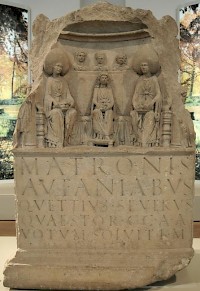
However, because the temple of Nehalennia was situated near the estuary of the Scheldt, and because of the short inscriptions, we know something about the cult of this goddess. This cannot be said of the other gods and goddesses known from votive altars. Hundreds of monuments are dedicated "to the mothers" (matres or matronae), but we do not even have the beginning of an idea who they may have been. We know many names: the Alaferhuic mothers, the Aufanian mothers (popular in Bonn), the Cartovallensic, the Rumaneheic and the Vatviaic-Nersihenic mothers. Some mothers seem to have limited their activities to one single ethnic unit, like the Hamavehic and the Hiannanefatic mothers of the Chamavi en Cananefates.
However, we do not know know whether they were protective deities (as has often been maintained), evil geniuses, or beings of an ambiguous nature (discussion over here).
Fortunately, there is one category of native gods and goddesses about whom we can know something. Several deities have a double (Latin and local) name, like Apollo Grannus, Mars Lenus, and Mercuriy Cissonius. The Batavian supreme god Magusanus was always equaled to Hercules, the masculine demigod who served as role model of a real man in the Mediterranean world. Obviously, the Batavian god and this macho had something in common, but we do not know what this might have been. (Things become really complex if the fertility god venerated at Elst was indeed Hercules Magusanus, because Hercules is not known as a fertility god.)
A complication is that one Roman god could be identified with several local deities. For example, both Cissonius and Gebrinius -whoever they may have been- were equaled with the Roman god Mercury, the patron of merchants, guide of the dead souls, protector of thieves. One or several of these traits must have appealed to the native population, but we cannot know which.
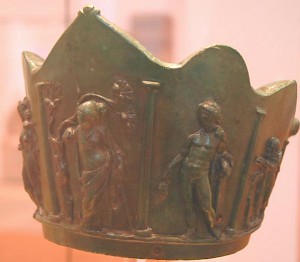
Inscriptions suggest a bewildering variety of religious beliefs, but we do not understand much of these. The Alaisiagae sisters, the goddess Beda, the goddess Fimmilena and Mars Thingsus were popular among the Tubantes, Haeva was venerated by the Batavians, and the Tungri worshipped Sunuxal and Vihansa. They are nothing but names. The situation is certainly comparable to the calendar of saints of the Catholic Church without the corresponding hagiographies.
Illustrations are the second type of evidence. In many native settlements, statuettes of Mediterranean gods have been found. However, this does not mean that the owners regarded these objects as representations of Mercury, Minerva, or Mars. If they kept them as objects with a religion significance (something that cannot be proven), it was probably because the objects shared attributes with a native god. For example, it has been plausibly been suggested that statuettes of the Egyptian-Roman goddess Isis were interpreted by the native population as representations of the Germanic goddess Nerthus.
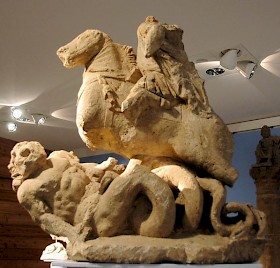
The problem that behind a familiar Roman form hides an unidentified native god, can also be illustrated with the example of the high, column-shaped monuments dedicated to what is called the Roman supreme god Jupiter. These columns have been found in the Rhineland, among the Treveri of the Moselle, in the country of the Tungri and among the Nervians. Usually, their square base is decorated with reliefs of the gods, and on their top is a statue of Jupiter, sitting on a horse, fighting against a monster. The ancient Mediterranean knew many myths about the struggle between the gods and the giants, but representations of the supreme god on a horse are absent.
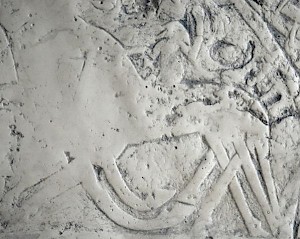
The closest iconographic parallel is the west-Germanic supreme god Wodan (or his northern alter ego Odin), who fought against the powers of darkness, seated on his horse Sleipnir. It is very likely that the Treveri, Tungri, Nervians and the inhabitants of the Rhineland have equaled these two deities, and told each other stories about Jupiter that once had dealt with Wodan/Odin. There is nothing strange about this. In Gaul, the old god Lugus had been renamed Mercury, but seems to have maintained something of his old character. Another example is the Christian Saint George, who was once known as Perseus.

Even the interpretation of the reliefs on votive altars remains difficult, although usually the name of the goddess is written on the monument. The altars of Nehalennia show a woman seated on a throne in an apse. A seat like this was the prerogative of the immortals, so we may be confident that the woman is the goddess (and not a priestess or a naiad). This much is certain. But we do not know the meaning of the attributes: the fruit basket on her lap; the dog or wolf next to her, and the ship beneath her foot. But does she trample on the ship, or is she protecting it? We do not know. Is the fruit basket a reference to the ancient belief that paradise was like an orchard with apple trees (cf. the Celtic Avalon)? Are the fruits a reference to the transitoriness of human life? Do they symbolize fertility? We do not know. And what to make of the animal? Is it a protective dog, man's best friend? Or is it a wolf and a predator? We do not know.
So, even when we can combine pictures and inscriptions, we are left with many uncertainties. Besides, there is an important drawback to the study of these objects: they offer information on the religion of people rich enough to pay for a large piece of natural stone, which had to be imported from Gallia Belgica. (Natural stone is absent from Germania Inferior.) Inscriptions and friezes, therefore, only inform us about the religion of the rich of the Rhineland. Moreover, nearly every monument was erected by a man. The information they offer is therefore only representative for the male half of the elite.
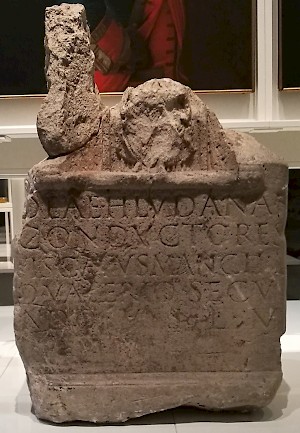
This restriction does not apply to the third type of evidence: the study of fairy tales, sagas and customs. Stories are told by rich and poor, male and female. Unfortunately, the results are disappointing. For example, from an inscription, we know of the existence of a goddess named Hludana. It has been assumed that this goddess is identical to the Frau Holle mentioned in the famous German fairy tales of the Grimm brothers. This Frau Holle is able to create snowfall, and therefore, it has been thought that Hludana was responsible for the weather. This is an attractive argument, but in fact, it is nothing but speculation, based on the assumption that the words Hludana and Holle go back to a hypothetical root *Hloda. An additional complication is that the German fairy tales were recorded in the nineteenth century, almost two millenniums after the period under discussion - and after great changes in the ethnic composition of our region.
The Edda's have already been mentioned. Several medieval legends and sagas contain information that goes back to Antiquity. For example, the famous Nibelungenlied describes the fall of the kingdom of the Burgundians in the fifth century. Texts like these have often been used as a tool to describe the ancient Germanic paganism 'from within', and there are some results. For example, we know that the inhabitants of the area that is now called Germany venerated Tiw, Wodan, Donar, and Freya. However, these results have almost nothing to do with the Low Countries. Only two names from Medieval legend may have ancient counterparts in Germania Inferior: it is probable that the goddess Hlodyn, the mother of Thor in the Icelandic Edda's, is identical to Hludana; and it is possible that the god Tiw is identical to the Thingsus venerated by the ancient Tubantes.
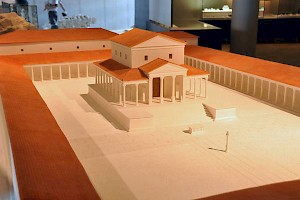
The fourth type of evidence consists of the writings of Greek and Romans authors. However, they are unreliable when they describe foreign cultures. They are fascinated by the wildness of the tribes on the edges of the earth, and are not above using the customs of one barbarian tribe to describe another. Therefore, we must be careful.
One example may suffice: the description of sacred groves. Holy forests are often mentioned, but this says as much about the obsessions of the Greeks and Romans as about the religious realities of Germania Inferior. Of course, it is not unlikely that the ancient inhabitants of the Rhineland venerated sacred trees and forest gods, but it is just as likely that the Greek and Roman authors, obsessed with the forests they knew to exist on the edges of the earth, gave too much attention to sacred groves.
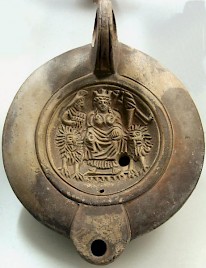
Summarizing: inscriptions, illustrations, fairy tales, sagas, and customs, and the writings of ancient authors enable us sometimes to catch a glimpse of the native religion. Nothing more. It is only when we can localize and excavate a sanctuary, that we gain some certainty. The presence of medical instruments in a temple in the Nervian town Velzeke in Gallia Belgica, for example, suggests that a god with curative powers was worshipped (e.g., Aesculapius or a native colleague).
Another example is the excavation of the sanctuary of Magusanus (as we have already seen, a strapper like Hercules) at Empel on the Lower Meuse near Den Bosch. Many votive gifts have been found near the temple, especially old weapons. Because weapons are very uncommon gifts to the gods in the Roman world, it is reasonable to assume that the god of Empel was venerated by the Batavian auxiliaries. Or, to be more precise, by retiring soldiers, who were grateful to the god for the protection they had received during their career in the army, and ritually laid down their weapons in this sanctuary.
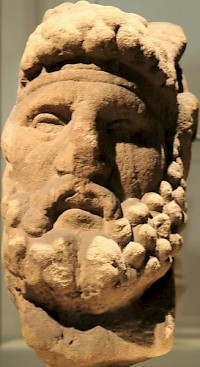
Unfortunately, religious sites like Empel are rare in Germania Inferior. Besides, only a part of the cult is understood. How the demobilized felt during the ceremony, what kind of processions took place, which myths circulated, whether the soldiers were the only people sacrificing, how the god appealed to those present, what kind of sacrifices were expected (and when), how the prayers and hymns sounded - we simply cannot know.
Finally, it must be noted that we cannot assume that the religion of Germania Inferior always stayed the same. Of course, there were changes, especially in the cities. We know of the existence of an underground sanctuary for Mithras at Krefeld; a statuette of Isis has been excavated at Valkenburg; Cybele was immensely popular; near Bonn, Ammon was venerated; the Syrian sun god Elagabal had worshippers in Woerden; and there were Jews living in Cologne. The first of these gods is from Iran, the second and third are from Egypt, and the Jews were, of course, from Judaea. This shows that the inhabitants of Germania Inferior -or at least those living in the southern part- were fully integrated in the Roman world.